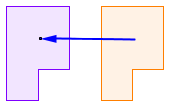Transformational Geometry for Teachers: A guide to the materials on this page.
It can serve as a transformations syllabus for the professional development
of teachers and future teachers of high school geometry.
One of the features of the Common Core standards in secondary school is a change in the foundations of geometry. Instead of basing everything on congruence and similarity postulates, as is traditional, the idea is to build on a basis of geometric transformations: translation, rotation, reflection, and dilation. This is an interesting change, but it is so fundamental that it may meet with some resistance.
Here is a pedagogical argument for the change: congruence postulates are pretty technical and far from self-evident to a beginner. In fact, many of us explain the basic idea of congruence by saying something like "if you can superimpose two figures, they are congruent." Well, that is not very far from saying "if you can move one figure to land exactly on top of the other, they are congruent." In other words getting at congruence on the basis of transformations is more intuitive than going in the other direction.
There are also mathematical arguments for the change: geometric transformations tie in nicely with such concepts as functions, composition of functions, inverse functions, symmetry, complex numbers, and matrices.
One of the consequences of this change is the need for a lot of professional development to acquaint teachers with the mathematics and pedagogy of the new approach, and to make the connections with old and new parts of the curriculum. I hope I will be able to help with that: as it turns out, I have taught transformational geometry and its connections to a number of related topics as part of my Space course for more than 20 years.
Curricular Materials
- Symmetry (grades K-12)
- Lessons, labs, and connections
- Hands-On Introduction (grades 8-10)
- Isometries
- Dilation
- Congruence and Similarity
- Symmetric Polygons (co-authored with Lew Douglas)
- Applets
- Isometries
- Dilation
- Space Course (grades 11-12)
- Overview, including a bibliography
- Transformational geometry and symmetry syllabus
- Isometries of the Plane
An advanced unit, going beyond Common Core requirements
- Computing Transformations (TI-89 | GeoGebra):
Using complex numbers and matrices (these are '+' Common Core topics)
- GeoGebra Files
- Introduction to transformations
- Composition
- Complex numbers and matrices
- Teacher's notes on these files.
For Teachers and Curriculum Developers
Triangle Congruence and Similarity
Triangle Congruence and Similarity, v1
With Lew Douglas: Triangle Congruence and Similarity, v2
These documents are intended to support teachers and curriculum developers who are wrestling with the logical relationship between transformations and the congruence and similarity criteria. Both offer a pedagogically sound and Common-Core-compatible approach to the subject, basing the congruence criteria on geometric construction. The first version (which I wrote alone) is perhaps more opinionated, and includes possibly useful footnotes. The second version (co-authored with Lew Douglas,) much improves the section on similarity, and includes a great proof of a fundamental property of dilations.
Transformational Proof
- Transformational Proof in High School Geometry (updated: March 2018)
- This document is a logically coherent presentation of a substantial portion of a high school geometry course, based on geometric transformations. It incorporates and extends the ideas we introduced in "Triangle Congruence and Similarity" above.
Similar Graphs
- Thinking about graphs as geometric objects
- All parabolas are similar: see Geometry of the Parabola (2D) | Worksheet
- All exponential graphs are similar: see Exponential Functions
The Glide Reflection
The glide reflection is an isometry that is missing from the Common Core. It is worth knowing about for two main reasons. One is that it is one of only four types of transformations that connect any two congruent figures in the plane (see below). The other is that it is needed in the study of symmetry. Read an introduction to the glide reflection here.
Only Four Kinds of Isometries
Epic proof that any isometry of the plane is one of these four: reflection, translation, rotation, or glide reflection, with interactive figures.
